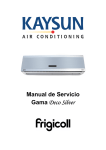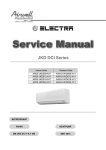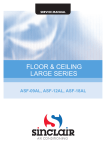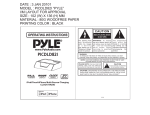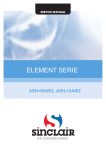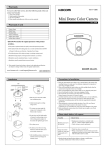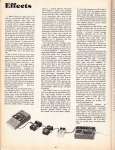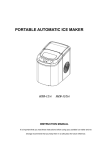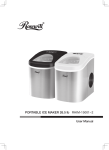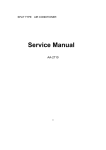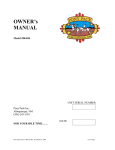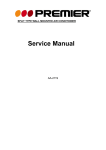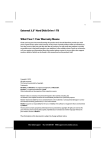Download Service Manual
Transcript
Service Manual SPLIT TYPE CEILING CASSETTE AIR CONDITIONER Service Manual AA-2117 1 Service Manual CONTENTS 1. Range & Conditions Operating Range……………………………………………………………………………...2 Operating Conditions ………………………..……………………………….………….…2 2. Specifications Unit Specifications………………………………………………………….…………………3 Specifications of Main Parts………………………………………………………………….4 Specifications of Other Parts……………………………… ………………………………..6 3. Functions Control Functions……………………………………………………………………………..7 Operating Mode……………………………………………………………………………….7 Protect Functions……………………………………………………………………………..9 Other Functions ……………………………………………………………………………..10 Temperature Table of Prevent Point ………………………………………………………12 4. Dimensional Data………………………………………………………………..13 5. Performance Charts……………………………….………………..………….15 6. Refrigerant Flow Diagram…………………………………………….……....16 7. Circuit Diagram Electrical Wiring Diagram for Indoor Unit…………………………………………………18 Electrical Wiring Diagram for Outdoor Unit…………………………………….………..19 8. Troubleshooting Check before Troubleshooting……………………………………………….…………….20 Air Conditioner Does Not Work…………………………………………………………….20 Some Parts of Air Conditioner Do Not Work……………………………………………...22 Air Conditioner Operates, But Abnormalities are Observed. …………………………...24 Sensor is Defective………………………………………………………….………………26 9. Checking Electrical Components. …………………………………………..26 2 Service Manual Technical Data 1. Range & Conditions 1.1 Operating Range Operating Modes Temperature Indoor Temperature Outdoor Temperature Max. 32℃ DB/27℃ WB 43℃ DB Min. 21℃ DB/15℃ WB 21℃ DB Cooling 1.2 Operating Conditions Rated Operating Conditions Indoor Temperature Outdoor Temperature Cooling 27℃ DB/19℃ WB 35℃ DB/24℃ WB Heating 20℃ 7℃ DB/6℃ WB Tubing Length (m) 4.0 Max. Operating Value Indoor Temperature Cooling 32℃ DB/23℃ WB Outdoor Temperature 43℃ DB DB: Dry-bulb temperature WB: Wet-bulb temperature 3 Service Manual 2. Specifications 2.1 Unit Specifications Power supply 220V~ 60Hz (single phase) Rated voltage V 220 Btu/h 9000 Performance Rated capacity 3 m /h 480 l/h 1.0 V 198~242 A W W/W 4.5 980 2.65 Air circulation(High) Moisture removal (High) Electrical rating Voltage range Operating current Power input E.E.R / C.O.P Features Controls / Temperature control Microprocessor / I.C thermostat Control unit Infrared remote control transmitter Timer ON/OFF 24 hours Fan speed Indoor /Outdoor High, Medium, Low, Auto /High Horizontal Vertical Airflow direction Manual Auto Air filter Anti-mold, washable Compressor Rotary-type (Hermetic) Refrigerant /g R22 / 600 Refrigerant control Capillary tube Indoor Outdoor Noise dB-A dB-A 40 52 Pipeline connection manner Max. pipeline length Refrigerant tubing diameter (in) Flare m 9.0 Narrow tube mm 6.35 (1/4”) Wide tube mm 9.52 (3/8”) Indoor unit Dimensions & Weight Unit dimensions Package dimensions Weight Height Width Depth Height Width Depth Cross weight mm mm mm mm mm mm kg Outdoor unit 675 430 265 820 535 385 16 25 Data subject to change without notice 4 Service Manual 2.2 Specifications of main parts 2.2.1 Indoor unit AA-2117 Controller Part No. JUK6.672.848 Controller Microprocessor Fuse 250V T3.15A KK10B-C2 Remote controller Fan & Fan motor Type Cross-flow fan Quantity / Diameter / Length mm Fan motor model 1 /Ф86 /640 Welling: RPG20E-2 Pole / Rotation of motor 4 / 1250 (rpm, 220V High speed) Rated power output W 16 Coil resistance red-purple: 290±15%, Ω (Ambient temp 20℃) purple -white :403±15% μF 1.0 VAC 450 Operating capacitor Louver motor Type Step motor Model ZTC1.01 Rated voltage V Coil resistance Ω (Ambient temperature 25℃) 12VDC±10% 80Ω±10% Heat exchanger Fin Aluminum fin / Copper tube Row 1 Row pitch mm 2 Face area m 1.4 0.144 Data subject to change without notice 5 Service Manual 2.2.2 Outdoor unit AA-2117 Controller PCB Part No. - Fuse - Compressor Controller model Highly: SD134SN-H3AU Compressor power input Compressor oil / Amount W CC Overload protector Highly: DIAMOND MS-56 / 270 Highly: BF840-KB Compressor locked rotor amperes A Ω Coil resistance (Ambient temp 20℃) Operating capacitor 895 μF/ VAC 21 Highly: C-R: 3.53, C-S: 4.02 Highly: 25/ 450 Fan & Fan motor Type Amount / Diameter Propeller fan mm Fan motor model / amount 1 /Ф400 Welling: YDK19-6V-2/ Pole / Rotation of motor (220V, High speed) rpm 6 ..860 Rated power output W Coil resistance (Ambient temp 20℃) Ω 19 white-gray :254±15%,/ brown-white:150±15%/ Safety devices Open : 130±8℃ Close: 82±15℃ μF 2.0 VAC 450 Operating capacitor Heat exchanger Fin Aluminum fin / Copper tube Rows Fin pitch 1 mm 2 Face area m 1.4 0.177 Data subject to change without notice 6 Service Manual 2.3 Specifications of other parts Indoor unit Transformer DB-13-01 Indoor temperature KTEC-41-C12 Thermal resistor Coiled pipe Resistance temperature 25℃ KTM-41-C9 10 K Ω Power supply length (m) / cross section AWG16 Rated value 15A, 250VAC Power relay JQX-102F-012-P Coil rated voltage, 12V±10%, 20A Current coil resistance(20℃) 160Ω 2.5 Outdoor unit Data subject to change without notice 7 Service Manual 3. Control Specifications 3.1 Control functions 3.1.1 Switches input: Press on / off button in the off mode. The air conditioner is turned on and works at 24℃ in sweep mode automatically. Press the button when the unit is running or in test run mode, air conditioner is turned off. Press the button over four seconds until the buzzer beeps twice. Air conditioner enters the test run mode. Users can use the remote controller to turn off the units or change the running mode. The air conditioner will start the normal operation automatically if the test running time is for more than 15minutes. Air conditioner will stop and exit the test run mode when users press on / off button which is on the indoor unit or on the remote controller. 3.1.2 Temperature control: Remote controller will transmit indoor temperature and other information to indoor unit every 3 minutes. If the master controller MCU can ’t receive remote signal for 10minutes, air conditioner will control the running automatically by indoor temperature sensor. When indoor temperature sensor is being used, It has 3℃ temperature compensation in heating mode. There is no temperature compensation in cooling and dehumidification mode. 3.1.3 Sleep mode: For better comfort in sleeping and energy saving. Temperature will be adjusted automatically when the sleep mode is set. The set temperature will increase 1℃ after running 1 / 2 hour in cooling and dehumidification mode, and 1℃ after another 1 / 2 hour. Temperature will decrease 2℃ after running 1 / 2 hour in heating mode, and 2℃ after another 1 / 2 hour. The set temperature will be controlled between 16 ℃ and 30℃. 3.2 Operating mode 3.2.1 Auto-operating mode: When air conditioner stars running or the set temperature is adjusted under this mode. Master controller MCU can select running mode automatically by indoor temperature and set temperature. It runs in cooling mode when Tr≥Ts (Tr: Room temperature, Ts: Set temperature) and in heating mode when Tr<Ts. In heating mode, When Tr≥Ts+3℃ lasts for 15minutes. It turns into cooling mode. In cooling mode, when Tr≤Ts-2℃ lasts for 15 minutes. It turns into heating mode. When Ts-2℃< Tr < Ts+3℃,it turns into original mode. Temperature control range: 16℃-30℃; Original value:24℃; Temperature control precision:±1℃; 3.2.2 Cooling: Temperature control range: 16℃-30℃; Original value:24℃; Temperature control precision:±1℃; Characters on control: 4-way reversing valve closes: 8 Service Manual When Tr≥Ts+1℃, compressor runs. When Tr≤Ts℃, compressor stops. The control circuit will stop compressor only after it has run at least 5minutes.The compressor can be restarted 3minutes later the turn-off. Fan speed control: Auto: When Tr>Ts+2℃, high speed; When Ts+1℃≤Tr<Ts+2℃,medium speed; When Tr< Ts+1℃, low speed. Manual: Users can select the fan speed of high, medium or low level as needed in the turn-on status. Louver adjustment: 6 5 4 3 2 1 Close Manual: Set the louver position as needed. (Position 1-6 in the figure.) Auto: In the first 20 minutes of cooling operation. The louver is at position 4. After 20minutes, it runs automatically to position 6. 3.2.3 Dehumidification: Temperature control range: 16℃-30℃; Original value:24℃; Temperature control precision:±1℃; Characters on control: 4-way reversing valve closes. When Tr≥Ts+2℃,the running mode is the same to the cooling operation. When Ts-1℃< Tr < Ts+2℃, compressor and external fan motor run continuously. And internal fan motor runs between low wind for 10 seconds and breeze for 20 seconds continuously. When 15℃< Tr < Ts-1℃, compressor and external fan motor work for 3 minutes, then stop for 9minutes. When compressor is running, internal fan motor runs between low speed for 10 seconds and breeze for 20 seconds. Internal fan motor runs at breeze while compressor is off. Internal fan motor stops working 30 seconds later the turn-off of compressor. When Tr≤15℃, indoor and outdoor unit both stop working . Louver blades can be controlled. Louver adjustment: Manual: Users can set the position as needed. (Positions 1-6 in the figure) Auto: The sweep range is fixedaat position 6. 3.2.4 Heating Temperature control range: 16℃-30℃; Original value:24℃; 9 Service Manual Temperature control precision:±1℃; Characters on control: 4-way reversing valve opens. When Tr≤Ts-1℃, compressor , 4-way reversing valve and external fan motor all open . When Tr≥Ts+1℃, compressor and external fan motor both close. Indoor fan motor blows breeze. When Trc (Trc: The indoor coiled temperature) drops blow F℃, Air conditioner enters into cool- airflow prevention operation; Pause indicator lights. Fan speed control: Manual: Users can select the fan speed of high, medium or low level as needed in the turn-on status. Auto: When Tr< Ts-2℃, high. When Tr≥Ts-2℃,medium. Louver adjustment: Manual: Users can set the position as needed. (Positions 1-6 in the figure) Auto: When Trc<39℃,the sweep range is at position 5. When Tr≥42℃, the sweep range is at position 4. When 39℃≤Tr<42℃,the sweep range keeps at original position. Compressor control: The control circuit will stop compressor only after it has run at least 5 minutes. Compressor can be restarted 5 minutes later the turn-off. 3.3 Protect functions 3.3.1 Delay-starting protection for the compressor. Compress will restart working 3 minutes (5 minutes in heating) later the turn-off of compressor or power-off to keep the pressure balance of the cooling system. 3.3.2 Cooling air flow protection: In heating operation, when Trc<F℃,and compressor stops or the running time of compressor is not more than 5 minutes. Air conditioner will enter into the cool-air-flow protection. Louver runs into the position 6 and can ’t be controlled. Internal fan motor stops and pause indicator lights. 3.3.3 Freeze-prevention: To prevent indoor heat exchanger freezing in cooling and dehumidification operation. Compressor will stop running when it runs at least 10 minutes and Trc≤-2℃. If compressor is off for more than 6 minutes, or the coiled pipe temperature rises above 8℃ and compressor is off at least 3 minutes. Compressor will restart working. 3.3.4 Heating overload working: When Trc≥A℃, the unit enters into overload protection. And indoor fan speed should be adjusted to a higher level automatically. When Trc≥B℃, outdoor fan stops. And it will restart working when coiled pipe temperature drops 10 Service Manual to D℃. Air conditioner will exit overload protection when coiled pipe temperature drops blow E℃. Indoor fan motor resumes to the normal status. Compressor will stop when the coiled pipe temperature is above C℃ and the build-up time of compressor running is for more than 5 minutes. 3.3.5 Defrost: A: Defrost conditions. a. Indoor unit enters into overload prevention and outdoor unit stops. When outdoor fan motor runs for more than 10 minutes, and the build-up time of compressor running is for more than 50 minutes, Toc≤A-1℃ ( Toc: Coiled pipe temperature of the outdoor unit.) b. Not overload, but Toc drops blow -17℃ for 30 seconds. The build-up time of compressor running is for more than 25 minutes. c. The build-up time of compressor running is for more than 3 hours. And Toc drops blow -2℃ for 5 minutes. Trc≤G-2℃ and Trc≤(Tr+H)℃. d. The build-up time of compressor running is for more than 3 / 2 hours. And it reaches the condition of the unit stopping. Toc drops blow -2℃ for 3 minutes(overload).or Toc≤-2℃ and Trc≤G+2℃ (not overload). e. The build-up time of compressor running is for more than 50minutes. Toc ≤-2℃, Trc drops at least 3℃ and Trc≤G℃, Trc≤(Tr+H) ℃. It will defrost under the one of the conditions. B. Defrost: Compressor and outdoor fan motor will stop working after entering into defrost running. 55 seconds later, 4-way reversing valve will close. Another 5 seconds, compressor starts running. When the time of the compressor running is for more than 10 minutes or outdoor coiled temperature is above 20℃, Compressor stops. 55 seconds later, 4-way reversing valve will open. Another 5 seconds later, compressor and outdoor fan motor will restart working and exit defrosting operation. In defrosting operation, the time of compressor running is at least 3 minutes. Cool airflow prevention and heat blowing are both efficient. 3.3.6 Troubleshooting display and prevention. a. Pause indicator flashes quickly --- The driver or the control current of the louver is abnormal. And the louver blades do not work. b. Timer indicator flashes quickly --- The circuit of PG motor is abnormal; air conditioner stops. c. Running indicator flashes --- The circuit of outdoor coiled temperature sensor is abnormal. The unit can’t run in heating mode. d. Pause indicator flashes --- The circuit of the temperature sensor is abnormal. The unit runs in 24℃. e. Timer indicator flashes --- The circuit of the coiled pipe of indoor temperature sensor is abnormal. The unit can’t run in heating mode. 3.4 Other functions 3.4.1 Auto-diagnosis Test terminal on the main panel is shorted. The Auto-diagnosis functions are in the following steps when the power is turned on. Buzzer beeps 1s → No output 0.5s → Running indicator on 0.5s → Timer indicator on 0.5s → 11 Service Manual No output 0.5s → Compressor 0.5 → Outdoor fan motor 0.5s → 4-way reversing valve 0.5s → Electric heating 0.5s → Indoor fan motor 0.5s → Flap-a0.5s → Flap-b0.5s → Flap-c0.5s → Flap-d0.5s → No output 0.5s → Complete output 1s. In the Auto-diagnosis operation, the buzzer beeps if the circuits of the two indoor temperature sensors are abnormal. 3.4.2 Timer saving: The time-shortening terminal on the main panel is shorted when the unit is powered on. The buzzer beeps twice and the master controller CUP runs as 60 times as the former speed. 3.4.3 HA input: Posed with 200-300ms high level on the HA input end, the unit is turned on. Posed with 500-600ms high level on the HA input end, the unit is turned off. The unit runs in the former mode when restarted. 3.4.4 Auxiliary electric heating: (1) The starting conditions of auxiliary electric heating. a. In heating or Auto mode. b. Compressor runs for more than 1 minute. c. Tr≤14℃. d. Ts-Tr≥6℃. e. Indoor fan motor is running. (2) Auxiliary electric heating will be closed under the one of the following conditions. a. Tr≥18℃. b. Ts-Tr≤2℃. c. Trc≥A-2. d. Indoor fan motor stops working. e. The unit enters into defrosting operation. Note: The electric heating will be off when the temperature reaches point C, and it will be restarted when the coiled pipe temperature of indoor unit drops blow D-1℃ and it is satisfied with all the conditions of (1). (3) Defrost when electric heating is running. If electric heating is running or the turn-off time is less than 10 minutes. It will enter into defrosting operation and indoor fan blow breeze for 1 minutes. (4) The unit is off when electric heating is running. If electric heating is running or the turn-off time is less than 10 minutes. The indoor fan motor will blow breeze for 1 minute. 3.5 Temperature table of preventing point Model AA-2117 A B C D E F G H 49 52 65 44 42 32 36 24 12 Service Manual 4. Dimensional data 4.1 Unit 4.1.1 Indoor unit 4.1.2 Outdoor unit Note: The above figures are only schematic, and they may be slightly different from the actual appliances you bought. 13 Service Manual Exploded view for indoor unit NO. NAME CODE 1 WIND-ABSORPTION BAR BRACKET ASSEMBLY 11 2 AIR FILTER 12 INDOOR FAN 13 LEFT FILTER BRACKET ASSEMBLY 14 COVER 3 WIND-ABSORPTION BAR 4 AIR GUIDING BOARD 5 FAN MOTOR ASSEMBLY 6 RIGHT FILTER BRACKT ASSEMBLY UPPER COVER 15 14 16 BEARING ASSEMBLY ASSEMBLY TRANSFORMER INDOOR ELETRIC Service Manual CONTROL ASSEMBLY 7 INDOOR FAN MOTOR 17 Air outlet guid 8 EVAPORATOR ASSEMBLY 18 DRAIN CANAL ASSEMBLY Air supply shelf Ass’y 19 DRAIN BOARD 9 10 Air shutter Ass’y 20 Exploded view for outdoor unit 15 CANAL INSTALL Service Manual 5. Performance Charts A t n e r r u c g n i t a r e p O ( ) (℃) O u td o o r in le t te m p e r a tu r e ( D B ) ( ℃ ) Note: Over prevention operates to protect the air conditioner when the outdoor ambient temperature reaches an abnormally high level while in heating mode. ●……Points of rating condition Note: The speed of the indoor unit is high. 6. Refrigerant Flow Diagram Outdoor unit Indoor unit Service valve Compressor Joint Pipe Indoor heat exchanger Outdoor heat exchanger Strainer Service valve Pipe Capillary tube 16 Joint Service Manual Thermal insulating of refrigerant pipeline To prevent heat loss and condensed water from dropping on the floor, the wide and narrow tube of air conditioner should be wrapped with thermal insulating materials. For using capillary tube, and the tubes are in low temperature, the thickness of thermal insulating materials shall be more than 8mm. 17 Model AA-2117 Narrow tube Ф6.35mm(1/4”) Wide tube Ф9.52mm(3/8”) Service Manual 7. Circuit Diagram 7.1 Electrical wiring diagram for indoor unit Warning To avoid electrical shock hazard, be sure to disconnect power before checking, servicing and/or cleaning any electrical parts. 18 Service Manual 7.2 Electrical wiring diagram for outdoor unit Warning To avoid electrical shock hazard, be sure to disconnect power before checking, servicing and/or cleaning any electrical parts. 19 Service Manual 8. Troubleshooting 8.1 Check before troubleshooting Warning: High-voltage will result in electric shock or death. Always cut off the power before checking and maintaining. 8.1.1 Check power line To check whether the power line is connected correctly according to the wiring diagram. 8.1.2 Check unit wiring To check whether the inter-unit wires are connected correctly. 8.1.3 Check power supply To check whether the power supply is in the specified range (220±10%). To check whether the power supply is being supplied. 8.1.4 Check connector and lead wire of indoor and outdoor units. To check whether the insulating cover of the lead wire is damaged. To check whether the lead wire and the connector are connected well To check wires. 8.2 The air conditioner does not work 8.2.1 A. Leakage protector is open or fuse is burnt. Setting leakage protector to “ON”, it opens immediately (can not reset). There is possibility of ground fault. Check insulation resistance (The insulation resistance shall be more than 2MΩ). B. Leakage protector is OFF. Disconnect unit wires from terminal No Poor insulation performance block of outdoor unit. And measure Measure the insulation resistance of insulation resistance of outdoor unit. the electric parts of outdoor unit. Disconnect unit wires from terminal No Poor insulation performance block of indoor unit. Unplug the unit and measure the Measure the insulation resistance of insulation the electric parts of outdoor unit. resistance of indoor unit. 20 Service Manual C. The fuse is open in several minutes after turning air conditioner on. Check the rated power of fuse. No Replace it with a proper one No Replace indoor fan motor. No Replace transformer. Yes Check the resistance of indoor fan motor coil. Yes Check the resistance of transformer coil. 8.2.2 The indoor and outdoor units do not work. Check power supply No 2. Check the breaker. Yes Check if something residue cover 1. Power failure Yes Clean it. on transmitting part of the remote controller. No Check if infrared receiver on Yes Clean it. indoor unit is dirt. No Check fuse on indoor PCB Ass’ y. Yes Check the resistance of fan motor coil of indoor unit. No Parts of indoor PCB Ass’ y or Measure the resistance of switches are defective. power transformer. 21 Service Manual 8.2.3 Only outdoor unit does not work: Check the set 1. The set temperature is too temperature. high for cooling operation. Yes 2. It is too low for heating Adjust the set temperature. operation. Measure the voltage between terminal No.1 and No.2 on the Ok terminal block (220V±10%) Outdoor unit is defective. No voltage indication. PCB Ass’ y of indoor unit is defective. 8.2.4 Only indoor unit does not work. Indoor PCB Ass’ y is defective. 8.3 Some parts of the air conditioner do not work 8.3.1 Only indoor fan does not work. Check the fan rotation Not rotate Check if foreign matter is in the fan cover. Ok Check if fan motor is broken Measure the resistance of motor coil. or foreign matter in bearing. Ok Check the capacitor of fan motor. 8.3.2 Only louver motor does not run. Measure the resistance of the louver motor coil. 22 Check the connector. Service Manual 8.3.3 Only outdoor fan motor dos not run. Not rotate Check the fan rotation Check if foreign matter is in the fan cover. Ok Check if fan motor is broken Measure the resistance of motor coil. or foreign matter in bearing. Ok Check the capacitor of the fan motor. 8.3.4 Compressor does not run. Overload protector activates. Check compressor capacitor. Measure the resistance The temperature of compressor is of too high. compressor coil. Measure the resistance of power Refrigerant is relay coil. Yes not enough. No Measure if power supply voltage is Rotor may be blocked. too low. 23 Fill it. Service Manual 8.4 Air conditioner operates, but abnormalities are observed 8.4.1 Bad shifting between cooling and heating mode (Not available in cooling type). Remote controller may be detective. Measure the coil resistance of 4-way reversing valve. Cooling Heating Ok Check the voltage between terminal No.5 4-way reversing valve is defective. and N0.2 on the terminal block (AC220) NO voltage PCB Ass’ y of indoor unit is in error. Cooling Heating Measure the voltage between terminal No.5 and No.2 on the terminal block (ov). 24 Service Manual Poor cooling or heating phenomena. Poor cooling Is the temperature (heating) set properly? Change the set temperature. performance Reduce heat (cool) source or The heating (cooling) change the air conditioner load is too large. Refrigerant with large power. 4-way reversing valve fails. Replace it Refrigerant is not enough. Filling it Capillary tube is blocked. Replace it. Compressor is in error. Replace it. Service valve is not open Open completely. completely. The air filter is blocked. Clean it. flow is not enough Air circulating capacity is it not enough. Fan running speed Change it to “high’ is at “low”. or “medium”. Connection between indoor Wide and narrow tubes and outdoor units is in poor are thermal-insulated. separately. Cooling air -flow 4-way reversing valve is defective. Cooling The pause indicator is on. airflow Replace it Replace protector is no use. thermal-insulated the electric controller of indoor unit. Temperature sensor indoor coil is defective. Note: 25 of Replace the sensor. Only in heat pump air conditioner. Service Manual 8.4.2 Over cooling or heating. Check the set temperature. 8.5 Sensor is defective 8.5.1 Temperature sensor of indoor heat exchanger is defective. The timer of indoor The sensor is unit is flash. open or short. Replace it. Definition of open or short circuit of sensor (thermal resistor): Short circuit: The protective cover of a lead wire has been damaged, and the exposed wire is touching another metal parts. Or both lead wires have become exposed and are touching each other. Or the circuit inside the temperature sensor is closed. Open: The lead wires are broken, or the circuit inside the temperature sensor is open. 9. Checking Electrical Components 9.1 Measure insulation resistance The insulation is in good condition if the resistance exceeds 2 M Ω. 9.1.1 Power supply wires Clamp the ground pins of the power plug with the lead clip of the insulation resistance tester and measure the resistance by placing a probe on either of the power wires. (Fig. 1) Then measure the resistance between the ground wire and the other power wire. (Fig. 1) 9.1.2 Indoor unit Clamp an aluminum plate fin or copper tube with the lead clip of the insulation resistance tester and measure the resistance by placing a probe on each terminal screw on the terminal plate. (Fig. 2) Note that the ground line terminal should be skipped for the check. 26 Service Manual 9.1.3 Outdoor unit Clamp a metallic part of the unit with the lead clip of the insulation resistance tester and measure the resistance by placing a probe on each terminal screw where power supply lines are connected on the terminal plate. (Fig. 2) 9.1.4 Measurement of Insulation Resistance for Electrical Parts Disconnect the lead wires of the desired electric part from terminal plate. Capacitor, etc. Similarly disconnect the connector. Then measure the insulation resistance. (Fig. 3 and 4) Note: Refer to electric wiring diagram. If the probe can’ t enter the poles because the hole is too narrow then use a probe with a thinner pin. 9.2 Checking continuity of fuse on PCB ass”y Remove the PCB ass’ y from the electrical component box. Then pull out the fuse from the PCB ass’ y. (Fig. 5) Check for continuity using a multimeter as shown in Fig. 6 9.3 Checking motor capacitor Remove the lead wires from the capacitor terminals, and then place a probe on the capacitor terminals as shown in Fig. 7. Observe the deflection of the pointer setting the resistance measuring range of the multimeter to the maximum value. The capacitor is “good” if the pointer bounces to a great extent and then gradually returns to its original position. The range of deflection and deflection time differ according to the capacity of the capaci 27






























